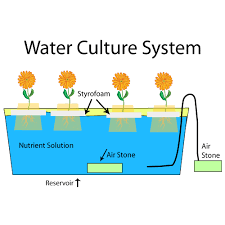Deep Water Cultivation Systems

A very basic schematic of a typical deep water cultivation setup. The nutrient solution tank serves as the pool upon which float styrofoam rafts. The rafts, in turn, hold up individual pots. The pots extend through the rafts, such that each plant's roots are continuously bathed in the nutrient solution. The air stone ensures that the nutrient solution contains sufficient oxygen for the roots, and circulates the nutrient solution to avoid stratification. Image adapted from www.hannainst.com.
You are on Page 1 of our six page series on deep water cultivation systems. Click on any of the below pages to jump to that page.
Page 1 Page 2 Page 3 Page 4 Page 5 Page 6
Deep water cultivation (DWC), also known as the raft technique, is a popular hydroponics method which may be one of the more unique hydroponic methods currently in use. The method involves the use of rafts which float on a reservoir of nutrient solution. Each plant is rooted in a pot, cup or plug which penetrates the raft, such that the plant roots dangle freely in the nutrient solution. The nutrient solution itself is circulated and aerated by the use of one or more airstones, which release small bubbles into the nutrient solution. The movement of the bubbles from the bottom of the reservoir to the top, also serves to circulate the nutrient solution itself.
One question which frequently comes up is “how deep does the reservoir have to be?” We’ll get that out of the way first. The answer is, it depends. It depends on the crop being grown, any existing facilities which are going to be adapted to deep water culture, and the environmental conditions. To start with, shallow-rooted crops such as lettuces can get by with a 6” reservoir depth, because their roots rarely ever grow longer than that. However, many sources recommend a reservoir of either 12” or 18” depth. They make this recommendation for two reasons. First, the additional depth helps ensure that the crops always have plenty of nutrient solution to work with. Any nutrient solution reservoir will slowly lose water, in part due to absorption by the plants and in part due to evaporation. The latter can be minimized by keeping the reservoir covered with rafts. However, the plants themselves will lose moisture through respiration. Having a deeper reservoir will help ensure that the water level doesn’t drop too quickly or the nutrient solution thin out. Secondly, the reservoir helps hold a steady root zone temperature, which many growers rely on to help create ideal growing conditions. The larger the reservoir, the easier it is to maintain that temperature without a lot of ups and downs.
Bottom line, deep water culture doesn’t require particularly deep water, and growers have some flexibility when designing a system. They simply need to keep the above variables in mind in the process. We’ll talk more about reservoir design later in this section.
Advantages
Deep water cultivation has some devoted fans, and for good reason. It has a variety of strong advantages in its favor. To start with, it can be one of the simpler hydroponic systems currently in use. This is because the nutrient solution is never piped to another location; it stays right where it is.
Secondly, the plants don’t need to move either; they stay right where they are from seedling stage to harvest. The rafts themselves may remain stationary, or might be moved from one location on the reservoir surface, for instance from a transplantation station to a harvesting station, with minimal handling required in between. The task of moving rafts along the surface of the nutrient solution is much easier than with other methods, because the nutrient solution itself carries most of that weight.
Third, there is little risk of the plants drying out due to a pump failure. The only way the plants would dry out is if the reservoir itself sprouted a leak and emptied, or if the raft somehow got high-centered on some other object such that the plant roots couldn’t reach the nutrient solution. The most common causes for other systems to dry out plants – broken or leaky plumbing, clogged emitters or a dead water pump – aren’t even used in this system.
Finally, the utter simplicity of the system lends itself well to automation. While this aspect of raft systems will only be used by a small fraction of growers, nevertheless it is an advantage to those growers who have the capital, and the desire, to automate their growing systems.
Next
You are on Page 1 of our six page series on deep water cultivation systems. Click on any of the below pages to jump to that page.
Page 1 Page 2 Page 3 Page 4 Page 5 Page 6